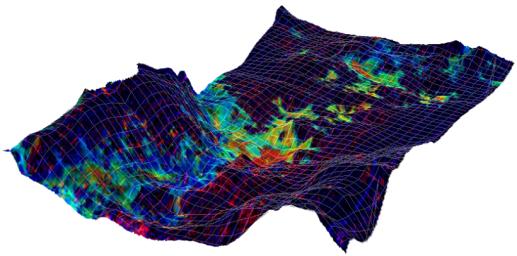
|
Clay Minerals in Mawrth Vallis Region of Mars
- Click the image above for a larger view
- Full-Res JPEG (832 x 412) (82.3 kB)
- Full-Res TIFF (832 x 412) (1.0 MB)
Caption:
This map showing the location of some clay minerals in of a portion of the Mawrth Vallis region of Mars covers an area about 10 kilometers (6.2 mile) wide. The map is draped over a topographical model that exaggerates the vertical dimension tenfold.
The mineral mapping information comes from an image taken on Sept. 21, 2007, by the Compact Reconnaissance Imaging Spectrometer for Mars (CRISM). Iron-magnesium phyllosilicate is shown in red. Aluminum phyllosyllicate is shown in blue. Hydrated silica and a ferrous iron phase are shown in yellow/green.
The topographical information comes from the Mars Orbiter Laser Altimeter instrument on NASA's Mars Global Surveyor orbiter.
Mawrth Vallis is an outflow channel centered near 24.7 degrees north latitude, 339.5 degrees east longitude, in northern highlands of Mars.
Background Info:
CRISM is one of six science instruments on the Mars Reconnaissance Orbiter. Led by The Johns Hopkins University Applied Physics Laboratory, Laurel, Md., the CRISM team includes expertise from universities, government agencies and small businesses in the United States and abroad. NASA's Jet Propulsion Laboratory, a division of the California Institute of Technology in Pasadena, manages the Mars Reconnaissance Orbiter for NASA's Science Mission Directorate, Washington. Lockheed Martin Space Systems, Denver, built the orbiter.
Cataloging Keywords:
| Name | Value | Additional Values |
|---|---|---|
| Target | Mars | |
| System | ||
| Target Type | Planet | |
| Mission | Mars Reconnaissance Orbiter (MRO) | Mars Global Surveyor (MGS) |
| Instrument Host | Mars Reconnaissance Orbiter | Mars Global Surveyor |
| Host Type | Orbiter | |
| Instrument | Compact Reconnaissance Imaging Spectrometer for Mars (CRISM) | |
| Detector | ||
| Extra Keywords | Color, Map | |
| Acquisition Date | ||
| Release Date | 2008-08-08 | |
| Date in Caption | ||
| Image Credit | NASA/JPL-Caltech/JHUAPL/MSSS/SETI Institute | |
| Source | photojournal.jpl.nasa.gov/catalog/PIA11011 | |
| Identifier | PIA11011 | |
